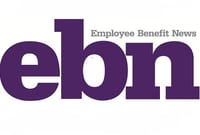 No, this article isn’t about the Presidential election. But this year’s election, which took place in the middle of a global pandemic, reminds us that some things are in our control, and some things aren’t.
No, this article isn’t about the Presidential election. But this year’s election, which took place in the middle of a global pandemic, reminds us that some things are in our control, and some things aren’t.
As with every election, we can control who we vote for, but we can’t be absolutely sure the candidates we vote for are going to win until the votes are counted. Remember the infamous Chicago Daily Tribune front-page headline “Dewey Defeats Truman” from November 1948?
However, sometimes, when we elect to do something, we can be assured that our choice will have its intended consequences—and will make a positive impact on many people’s lives.
Electing to put measures in place to reduce the likelihood of job-changing participants cashing out their 401(k) savings accounts is an example of this beautiful phenomenon.
According to the Employee Benefit Research Institute (EBRI), the U.S. retirement system loses $92 billion every year, primarily due to premature cash-outs of 401(k) savings accounts by plan participants. One of the major reasons for this trend is the lack of seamless plan-to-plan asset portability at the point when participants change jobs.
In its recent white paper, “The Impact of Small Amount Cash-Outs on Retirement Income,” Alight Solutions reports that, among 2 million participants it examined, four out of every 10 people who switched jobs between 2008 and 2017 cashed out their 401(k) balances within that period. Alight’s research reminds us that participants with the least 401(k) savings are the most likely to cash out. Among the 2 million participants whose data was reviewed, 80% of job-changers with account balances of less than $1,000 cashed out in the above timeframe (along with nearly two-thirds of participants with between $1,000 and $5,000 in their accounts).
If a 24-year-old participant cashes out a $3,000 401(k) account balance today, they would forfeit 5% of their projected 401(k) balance at age 67 (assuming the account would have achieved a 5% net-of-fees return per year), according to Alight’s calculations. The recordkeeper estimates that this 5% loss would translate to $23,000, or about one year of additional working income, that the participant would have had in their nest egg by age 67.
But significantly compounding this problem is plan sponsors’ conscious decision to continue automatically cashing out small accounts from terminated participants with less than $1,000. Indeed, according to Alight’s “2019 Trends & Experience in Defined Contribution Plans” report, 96% of plan sponsors will automatically cash out small, stranded accounts with below $1,000.
While this practice can help improve plan metrics such as average account balance, it opens sponsors up to potential liability as fiduciaries. If a former participant has moved since termination, and never contacted their former employer’s plan recordkeeper about their change of address, they likely wouldn’t receive the check for their hard-earned assets.
“Elect” for Auto Portability Instead of Automatic Cash-Outs
When evaluating their plan infrastructure, sponsors can elect to adopt technology solutions that prevent the need for automatic cash-outs (as well as automatic rollovers) entirely—and help participants improve their retirement outcomes.
Auto portability—the routine, standardized, and automated movement of a retirement plan participant’s 401(k) savings account from their former employer’s plan to an active account in their current employer’s plan—is powered by “locate” technology and a “match” algorithm. These solutions work together to identify and locate lost and missing participants, and then begin the process of transporting their account balances into their current-employer plans. By doing this, auto portability can improve the former-employer plan’s average account balance metric without the fiduciary liability baggage.
Live since 2017, auto portability has a track record of reducing cash-outs and increasing account balances among plan participants. A Boston Research Group case study focusing on a large plan sponsor in the healthcare services industry found that, four months after launching auto portability, the company’s plan participants were able to increase their average account balance by 48% after leveraging the program.
With Alight Solutions spearheading the nationwide adoption of auto portability, we are one step closer to bringing EBRI’s prediction—that up to $1.5 trillion in savings, measured in today’s dollars, would be preserved in the U.S. retirement system if auto portability were broadly implemented over a 40-year period—to reality.
That $1.5 trillion sum would include approximately $191 billion in retirement savings for 21 million Black Americans (and $619 billion for all minority workers).
This year’s Presidential election and COVID-19 have reminded us that many things are out of our control. But the power to help millions of Americans save more for retirement is in the hands of plan sponsors. All they have to do is elect to adopt the tools to enable the seamless plan-to-plan transfer of 401(k) balances at the point of job-change, rather than flushing those balances out through automatic cash-outs.
- Home
- Individuals
- Auto Portability
- Plan Sponsors
- The Small Account Problem
- RCH Portability Services
- Plan Sponsor Support
- The Missing Participant Problem
- What is a Missing Participant?
- Why Plan Sponsors Should be Concerned
- What Causes Missing Participants?
- The Magnitude of the Problem
- What Regulations Apply to Missing Participants?
- Sources of Uncertainty for Plan Sponsors
- Best Practices for Finding Missing Participants
- What to Look For in a Search Service
- Learn More About Missing Participants
- RCH's Missing Participant Search Service
- Terminating 401(k) Plans
- Participant Testimonials
- Due Diligence Material
- Contact Us
- Accountholders
- Company
- News & Information
- Login
